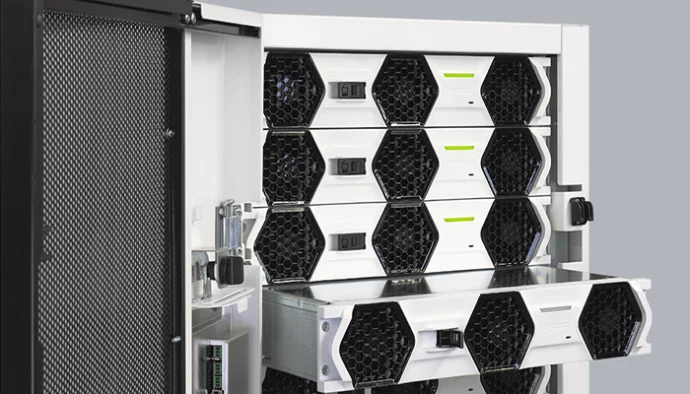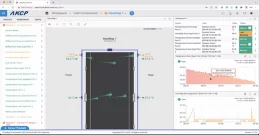The Key Benefits of Modular UPS for Growing Data Centres
Modular uninterruptible power supplies (UPS) have grown in popularity. They offer advantages over more traditional single or monobloc UPS systems. Whilst their initial cost may be higher, the benefits offered by modular power protection more than off-set the higher initial investment required.
Interest in modular UPS systems has increased, alongside organisations adopting hybrid computing to meet their IT requirements. With over 41% of businesses adopting hybrid cloud globally, there remains a growing demand for modular systems. Not just for UPS but other critical infrastructure systems in a server room or data centre, including cooling (air conditioners), environmental monitoring and fire suppression.
For more information on hybrid cloud adoption see:
https://www.frost.com/news/press-releases/information-communications-technology/strategic-hybrid-cloud-in-enterprise-it-to-improve-performance-and-data-regulation
To understand why modular UPS are better able to support hybrid IT strategies, it is important to first define a monobloc system.
What is a Monobloc UPS System?
An online UPS system consists of a rectifier, inverter, automatic static switch and may also feature a built-in manual UPS maintenance bypass for safe isolation during service or preventative maintenance. The connected DC power source can be a lead acid or lithium-ion UPS batttery or supercapacitors.
A conventional UPS system, whether floor standing or 19inch rackmount, is sometimes referred to as an example of a monobloc’ or ‘monolithic’ uninterruptible power supply design. The capacity of the UPS system is fixed at the UPS rating. For example, a 10kVA UPS is a 10kVA system, a 100kW UPS is a 100kVA system. The UPS is self contained in a single cabinet, with or without its DC power source.
To increase the capacity of a convential/monobloc UPS, a second or third (or more) UPS of the same size, must be added to the electrical circuit and their outputs combined through external LV switchgear or an external maintenance bypass. All the UPS systems must have a parallel card inserted to allow their onboard firmware to co-ordinate and synchronise their outputs.
N+1, or N+2, or N+X etc, refers to redundant operation. Redundancy is a form of resilience that ensures a system is available, should one of the modules fail or be taken out of circuit. The most common level of UPS system redundancy being N+1.
Redundant operation can be added to a monobloc UPS in the same way as capacity. The UPS require parallel cards to form a closed-loop network and one of the UPS provides redundancy.
What are Modular UPS Systems?
A modular uninterruptible power supply consists of a UPS frame that defines the overall capacity of the system. This could be 125kVA/125kW.
Inside the frame, individual UPS modules can be inserted. For a typical system, the UPS module may be sized at 25kW, with a 125kW frame taking up to 5 UPS modules. Each UPS modules can operate a single UPS system, having a rectifier, inverter and static bypass. The battery pack may also be modular and housed inside the UPS frame or installed as a separate external battery cabinet or rack.
| UPS Frame | UPS Modules | Overall UPS Size | UPS Redundancy |
|---|---|---|---|
| 125kVA/125kW | 1 | 25kW | none |
| 2 | 50kW | 25kVA N+1 | |
| 3 | 75kW | 50kW N+1 | |
| 4 | 100kW | 75kW N+1 | |
| 5 | 125kW | 100kW N+1 |
The capacity of a modular UPS is set by its frame-size, but multiple UPS frames can be placed in parallel operation in a server room or data centre to increase capacity. Most UPS manufacturers offer both monobloc and modular UPS systems including APC, Centiel, Eaton, Huawei, Legrand, Riello, Schneider Electric, Socomec, Vertiv.
The Key Advantages of Modular Uninterruptible Power Supplies
When planning a new server room or data centre, both monobloc and modular UPS systems should be considered for their operational and cost benefits.
- Increased system reliability
- Scalability for growth
- Smaller footprint
- Lower service costs
- Energy savings
Increased Uninterruptible Power Supply Reliability
A monobloc online UPS has an automatic static bypass which activates when the inverter output collapses; caused by a UPS short-circuit or internal fault, or overload. The load is automatically transferred to the mains power supply safely. This is referred to as safe-failure-to-mains. The connected load (servers and IT network) is then exposed to the risk of a mains power supply failure, with no uninterruptible power available.
Modular UPS provide a way to increase reliability and meet N+1 requirements. Having two or more UPS modules arranged in an N+1 configuration, shares the load between the UPS modules.
The number (N) of modules must be sufficiently sized to meet the full load capacity. An additional UPS module provides the ‘+1’ redundancy. Should one of the UPS modules fail or disconnected from the frame circuit, the other module automatically powers the load, and the critical power infrastructure is ensured uninterruptible power. There is no single point of failure.
Modular UPS are Easier to Scale
Whilst the overall UPS frame size and LV switchgear for the server room or data centre, must be taken into account at the installation planning stage, modular UPS are easily more scalable than monobloc UPS.
| UPS Type | Scalable Options |
|---|---|
| Modular | Vertically scale, adding UPS modules to the frame |
| Horizontally scale, adding another UPS frame | |
| Monobloc | Add another UPS system, if possible |
Where space is left within a UPS frame, one or more UPS modules can be added to the infrastructure to meet future capacity growth, whilst still maintaining N+x redundancy. This is referred to as ‘vertical’ scalability.
One or more UPS frames can be connected to the modular system, to provide additional capacity, whilst maintaining redundancy levels. This is referred to as ‘horizontal’ scalability. The additional UPS frame provides space for further UPS modules to be added.
In a monobloc UPS, a further complete UPS system is required, that may or may not be able to share a single battery pack.
Prefabricated data centres can also benefit from the modular approach to power protection. A single UPS frame can be installed with sufficient space to allow further modules to meet future demands.
Smaller Footprint in Computer and Server Rooms
Most modular uninterruptible power supply installations consist of a single compact UPS frame, and multiple modules, allowing vertically scalability. The overall footprint is like a large server cabinet (1000-1200mm deep).
The physical size of the UPS frame, reduces the overall footprint required, compared to a monobloc UPS, within a server room or data centre by around 30-40%. Freeing up space for additional server cabinets.
Serviceability and Lower UPS Maintenance Costs
UPS modules are generally ‘hot swappable’, allowing a mean time to repair (MTTR) of 30minutes or less. Their ‘hot swap’ design allows the modules to be removed from circuit, without the need for load interruption or the exposure of the connected IT load to a mains power supply failure during the removal or replacement of UPS modules.
Heavier UPS modules will require a lifting platform/table to remove and replace, safely. This is still significantly less impactful, than having to remove and replace an electronics card in a monobloc UPS, which will require complete isolation from the local mains power supply.
Modular UPS can have lower service costs, as their ‘hot swap’ feature can allow service and preventative maintenance work to be undertaken during normal working hours, rather than outside which an incur a cost penalty (weekend, bank holiday and work during the week after 5pm).
Where more than one modular frame is on site, spare modules can be placed within this and cycled automatically rather than kept a spares. This means that they are ready for use and operational, when required to be moved between UPS frames.
Higher Energy Efficiency and Lower Costs to Run
Energy savings are important aspect to consider as part of a total cost of ownership (TCO) calculation. With rising electricity cost and organisations looking to minimise their carbon footprint and meet sustainability goals, energy efficiency can be a differentiator when comparing UPS systems.
Whilst all modern uninterruptible power supplies are highly efficient, modular systems tend to cost less to run than a comparable monobloc UPS of the same size and N+X configuration, possibly by up to 10%.
In an oversized monobloc N+1 UPS, two complete systems are energised and operational. Should one fail, the other UPS can immediately support the load, without interruption.
In a modular design, the system monitors the load capacity and only shares the load amongst the minimum required number of modules. This means that those modules not required, can be allowed to power down to a ‘sleep’ / ‘hibernate’ mode state. If the load profile changes, or a module fails, the module(s) are brought online without interruption. This allows a modular system to automatically right-size its configuration to satisfy the load profile demands.
Overall, a modular UPS system’s energy efficiency should be around 96% or greater. This is in online mode. An alternative mode ‘eco’ may be available for more stable electrical sites, allowing the UPS to improve energy efficiency to 99% by operating as a line interactive system.
Summary
Modularity has always been a core concept in a server room or data centre. Where the system has a fixed size or capacity, such as the floor area available, cooling capacity or fire suppression system, this can limit future growth.
As businesses and organisations look to adapt their IT strategies to take advantage of the benefits offered by hybrid computing, they are also looking to adopt energy efficient systems, that can be right-sized for today or easily scaled to meet future load and capacity demands. The modular approach provides a more cost-effective and demand for systems that can easily scale will continue to grow.


























